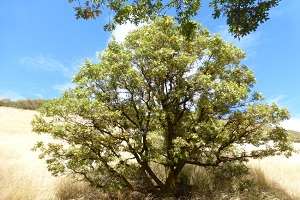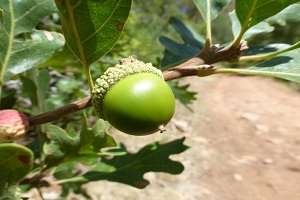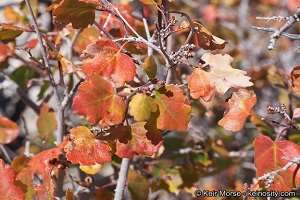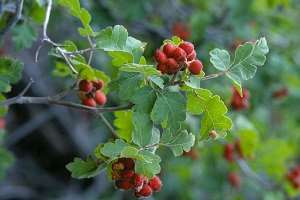By Harold McDonald
Whenever vacation plans turn to outdoor adventure, southern Utah is always near the top of my list. The dramatic scenery of places like Capitol Reef and Bryce Canyon has captivated millions, and I'm no exception! And though those places seem exotic and far away, you can actually get to Zion National Park quicker than Monterey Bay Aquarium.

Hiking in the Southwest, I often feel right at home, because so many of the native plants that I see there are species I grow right here in my own yard. Perhaps not surprising, given the climate similarities, but many of these are not California natives and are not widely available in nurseries here.

The trees that, for me, are most characteristic of much of the Southwest are junipers (several species), the single-leaf pinyon (Pinus monophylla, the world's only single-needle pine) and the Gambel oak, Quercus gambelii. While the first two are known and loved by Owens Valley residents, oaks are not common in our area. I have tried several species in my own yard, but the only one that has thrived is—you guessed it—Gambel oak. Native to mid-elevations of the Southwest (an alternate common name is Rocky Mountain oak), the Gambel oak doesn't reach the majestic stature of some of our Golden State oaks—the blue and black oaks of the northern two-thirds of the state, or even the coast live oak common along most of our coastline. Instead, the Gambel oak ranges from a large shrub to a small tree, growing slowly to 10-30 feet. Though small in stature, the Gambel has surprisingly large, very attractive leaves, 3-7 inches long, with 7-9 lobes. The leaves put on a great autumn show, turning yellow, orange and even red. The acorns have a somewhat whimsical look to me—smaller, rounder and more covered by their caps than the typical oak. They will thrive in nearly any soil. With my soil at the edge of the tablelands in west Chalfant, they'll probably stay on the small side, but in west Bishop's alluvial soils, I'm sure they would reach the top of their size range. Big Trees Nursery in Chalfant regularly stocks these trees, and I urge you to plant Gambel oak for a carefree smaller tree that looks right at home in the Eastern Sierra.
If you've got room for companions for your Gambel oak, you could consider one or more members of the Rhus genus. The sumacs have several representatives that are native to the Southwest. I have written previously in this blog about one of my personal favorites, Rhus ovata. The sugarbush is evergreen, 4-10 feet in height, and covered most of the growing season with very distinctive small red fruits. While this species isn't typical of southern Utah, it is very common around Sedona, Arizona (as well as the interior coast ranges of Southern California).


More typically in southern Utah, you will find two deciduous species, Rhus trilobata and Rhus aromatica. The former has been dubbed skunkbush for the odor of the cut plant, which I think is very unfortunate. Yes, it's not my favorite smell, but it's not that bad, and how often are you really going to cut the bush? R. trilobata is very useful as a totally carefree small bush that will rapidly grow to six feet tall and wide. The quail and other birds love it for its berries and the abundant cover it provides. With its red berries and divided leaves, it looks a bit like one of our local Ribes species. As a bonus, it has tremendous fall color. This is another one you can find locally at Big Trees or online from High Country Gardens.
Rhus aromatica, by contrast, has the common name of fragrant sumac because of its citrus fragrance. Though not found in California, it is common throughout the US, and while xerophytic like most of the genus, in southern Utah fragrant sumac seems to favor moister (mesic) sites than R trilobata. The native plant grows rapidly to five feet, but the most commonly available cultivar, ‘Gro Low,' reaches only two feet, but spreads rapidly to 6-8 feet wide, providing a tough, attractive ground cover with magnificent fall color. I bought mine from Bishop Nursery, but you can also find it online from High Country Gardens.
Source: ucanr.edu